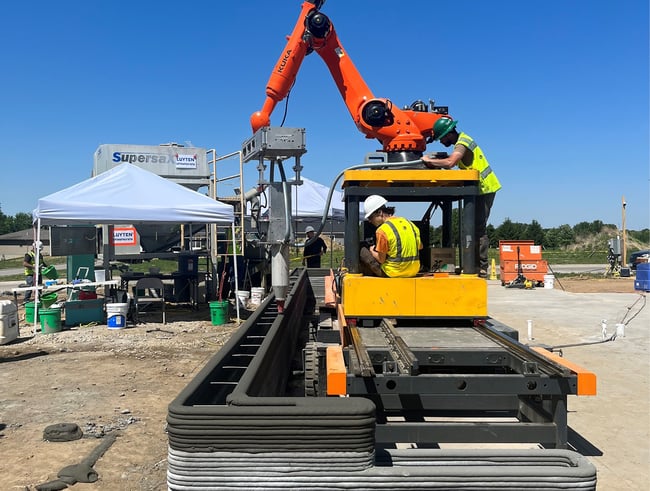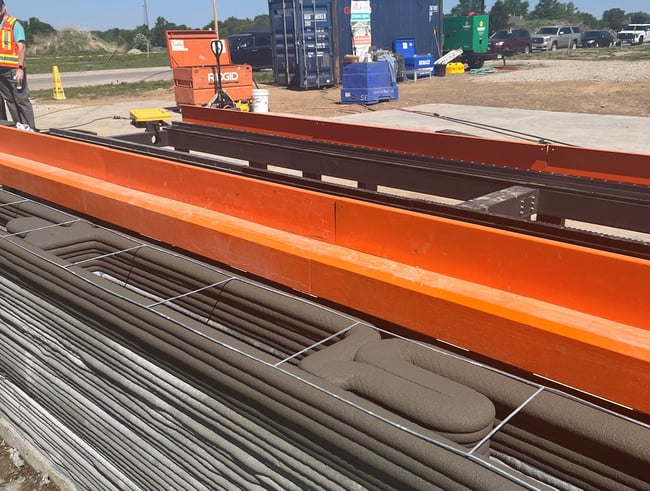3D printing is a groundbreaking development in the world of architecture and construction. While the technology is in its infancy, it has the potential to revolutionize the way we design and construct the built environment.
3D printing is quickly evolving, and many in the industry do not fully understand how it works or its potential applications. At Neumann Monson, we are becoming more accustomed to this technology as we design Print House, the first 3D-printed multifamily development in Iowa City.
This article will explain 3D-printed buildings by answering the following questions:
- What is a 3D-printed building?
- What are its benefits?
- What are its drawbacks?
- What building types fit 3D printing?
After reading, you will better understand how this technology works and whether it fits your building project.
What is a 3D-Printed Building?
3D printing, also called Additive Manufacturing, has been used for many years to create small-scale architectural models. Recently, developers have begun printing full-scale buildings.
While the science behind 3D printing is complex, the process is straightforward. An architect creates a digital model in a Computer Automated Design (CAD) program, which helps create a list of instructions for the 3D printer.
At the construction site, a robotic arm creates forms and surfaces through incremental deposits of material, typically concrete. Depending on the size of the project, a construction team may need to move the arm several times throughout the process.

A robotic arm deposits material to make walls.
Typically, 3D printing is used to construct exterior walls, though it can construct interior walls as well. Different nozzles can create a range of patterns and textures, expanding the design possibilities.
While 3D printing automates some construction processes, traditional trades are needed to complete roofing, electrical work, plumbing, interior finishes, and other parts of the building.
What are the Advantages of 3D Printing?
Although 3D printing is a new development, it offers many advantages over traditional construction. Its ability to quickly create tangible forms from durable materials can lead to a more efficient construction process and more resilient buildings.
Reduced Construction Timelines
3D printing has the potential to reduce construction timelines. On a smaller-scale project like a single-family home, a 3D printer can complete exterior walls in days.
It automates the process of creating a structural system and reduces the need for on-site assembly of prefabricated elements. 3D-printed buildings may lead to smaller construction crews, resulting in shorter lead times for labor.
Fewer Materials
One of the most exciting aspects of 3D printing is its promise to complete the building’s structural, weather barrier, and finish requirements with one material.
Completing a building envelope system on a traditional construction project requires several materials and trades. A 3D printer, however, can create two sets of concrete walls that a construction crew can fill with insulation. As this technology develops, fewer materials can lead to cost savings.

A 3D printer can make two sets of walls to be filled with insulation.
Structural Integrity
Often, 3D printers deposit materials like concrete. Compared to stick-built construction, concrete provides more structural integrity and can withstand high winds.
In areas affected by hurricanes or tornadoes, 3D printing presents the possibility of more resilient buildings. These events will only become more common with climate change, making efficient, resilient buildings a must.
Thermal Mass
Constructing with durable materials like concrete can also lead to energy savings.
Concrete provides thermal mass—a barrier that modulates internal temperatures by averaging day and night extremes. In winter, a concrete structure can absorb heat through contact with direct sunlight. This heat radiates throughout the interior as it cools at night. When shaded in the summer, concrete structures can absorb interior heat and release it outside at night.
In short, a 3D-printed building may be more effective at maintaining comfortable interior temperatures throughout the year—reducing the reliance on heating and cooling systems.
What are the Drawbacks of 3D Printing?
While 3D printing offers many benefits, it’s not without its drawbacks.
Currently, its cost is the greatest hurdle. Although 3D printing may one day reduce construction costs, it’s still largely experimental. Using this technology at this scale is new, and currently, construction costs are higher than the cost of a traditional building.
Likewise, many design and construction professionals are unfamiliar with this technology and its potential applications. Architects, structural engineers, and contractors may need additional time to understand its uses and find the most effective solutions.
Lastly, 3D-printed buildings have a large embodied carbon footprint. Despite the benefits of concrete, its production is energy-intensive and greatly contributes to global carbon emissions. Alternatives may be possible, but for now, concrete remains the most effective material for this application.
What Building Types Fit 3D Printing?
3D printing may fit a variety of building types, but currently, its use is largely limited to housing. During a housing shortage, 3D printing offers the promise of speed. Houses can be constructed on quicker timelines, helping developers fulfill market demands.
At the same time, housing is lower risk than other building types. Since 3D printing is a new technology, developers are using housing to experiment.
Larger developments are possible. Print House in Iowa City will be a two-story, multifamily development—showcasing the possibilities of 3D printing beyond single-family homes.
3D printing may also have some industrial applications, especially for buildings that require resiliency. Storage structures like grain bins may be constructed much faster with a 3D printer.
Learn More About 3D-Printed Buildings
While 3D printing holds great promise, there are many challenges to overcome. As more architects, engineers, and developers understand this technology, it may be possible to deploy it on larger scales and reduce construction costs.
For now, 3D printing offers many advantages for smaller-scale projects like housing. It can reduce material waste, shorten construction timelines, and create more resilient structures. As we look for ways to address challenges like housing shortages and climate change, 3D-printed buildings may become more common.
